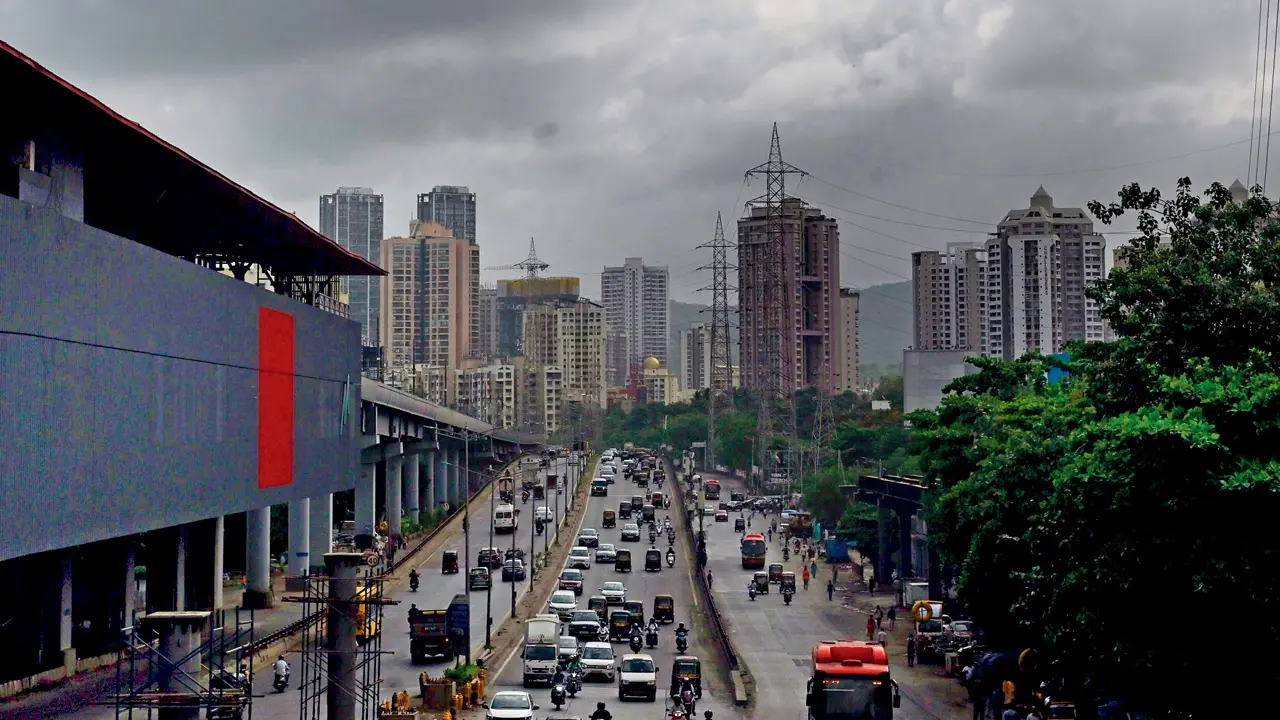According to the IMD, Mumbai’s forecast for Wednesday predicted “light to moderate rain/thundershowers”, but there was no sign of rain throughout the day. This absence of rain has caused humidity levels to fluctuate once again. As per IMD data, humidity levels in early May had touched 90 per cent, which dropped to around 60 per cent

Dark clouds loom over Kandivli East, as seen from the Western Express Highway yesterday. Despite early monsoon showers, Mumbai has been facing a dry spell for the past week. Pic/Satej Shinde
Just over two weeks ago, the city witnessed heavy rainfall, following which the India Meteorological Department (IMD) officially declared the early onset of the monsoon in Maharashtra, including Mumbai. However, for the last week, the city has been experiencing a dry spell. Despite the initial downpour and widespread alerts, the rain has all but vanished, leaving residents puzzled and coping with constant fluctuations in humidity levels.
According to the IMD, Mumbai’s forecast for Wednesday predicted “light to moderate rain/thundershowers”, but there was no sign of rain throughout the day. This absence of rain has caused humidity levels to fluctuate once again. As per IMD data, humidity levels in early May had touched 90 per cent, which dropped to around 60 per cent after the heavy rains that lashed the city on May 26. With no rain for the past week, humidity levels have once again climbed to approximately 75-80 per cent.
This abrupt pause in rainfall and the frequent fluctuations in humidity, health experts say, are not just meteorological anomalies but also public health concerns. While cold, cough, flu, and vector-borne diseases like dengue and malaria are common during the monsoon, doctors are now reporting a spike in allergies and other infections linked to these changes.
Severe nasal allergies
“When humidity increases, people tend to breathe heavily. This results in more germs being inhaled, especially if someone is spending more time outdoors than indoors. It leads to nasal tract irritation and allergies.
People then blow their noses forcefully, which can potentially damage their eardrums or lungs. I've also seen a rise in sinusitis cases. Those already suffering from sinusitis are especially vulnerable as bacteria flourish with fluctuating humidity levels. This leads to severe headaches and disorientation,” explained Dr Sanjeev Mehta, pulmonologist at Lilavati Hospital.
Sharing her experience, Meeta Dev, who suffers from minor asthma, said, “I had stopped using my pump in May because pollution and humidity levels had dropped. But after consulting my doctor, I discontinued it. I usually use it once a day since my asthma isn’t severe. However, last week I had difficulty breathing, and my doctor advised me to resume the pump twice daily for at least a month, as I had developed an allergy in my lungs.”
Fatigue and body pains
A senior doctor from one of the city’s civic hospitals noted a rise in complaints of body pain and mild fever. “Generally, when the monsoon begins, we see more cases of dengue and malaria, along with routine cough and cold. But in the last 15 days, we’ve seen more patients complaining of fatigue and severe body aches, especially joint pain. This can be attributed to the fluctuating humidity, which leads to increased sweating, especially among the working-class population,” the doctor explained.
Fungal infections on the rise
While fungal infections are typically associated with summer, the constant humidity changes make it harder for the body to adapt. “We’ve observed more cases of ringworm, especially in areas with excessive sweating, such as the skin folds. This is because blocked sweat glands lead to increased moisture and fungal growth. People prone to fungal infections should immediately change wet or sweaty clothes after reaching home or work,” said Dr Trupti Gilada, consultant infectious disease specialist at Saifee Hospital.
Doctors advise caution
As a preventive measure, doctors unanimously advise against self-medication during such transitional weather. “If the golden hour is missed, patients often require stronger medication later, which can have adverse effects on the body,” warned Dr Mehta. Instead, they recommend visiting a general physician at the first sign of health trouble during this delicate season.
 Subscribe today by clicking the link and stay updated with the latest news!" Click here!
Subscribe today by clicking the link and stay updated with the latest news!" Click here!










